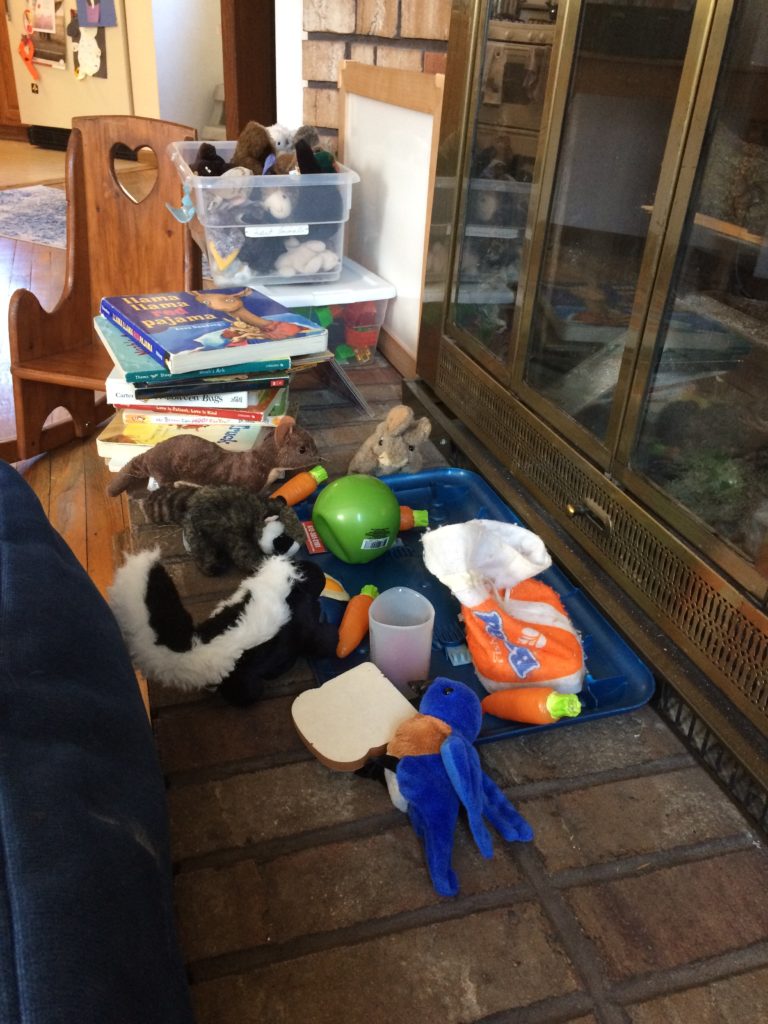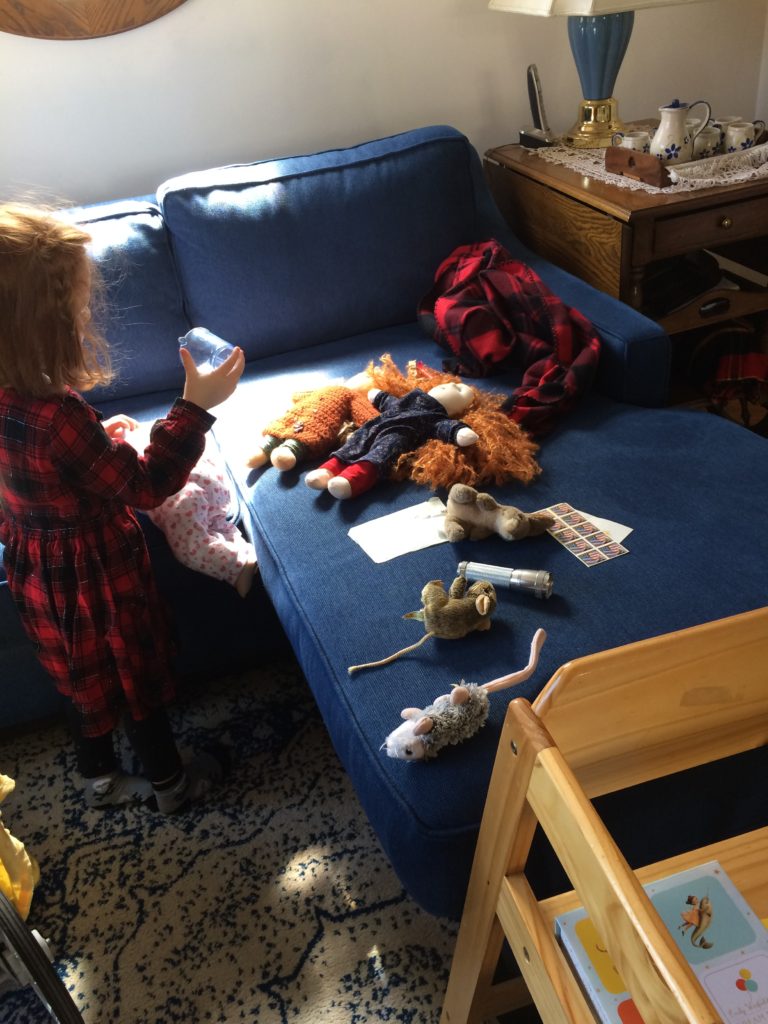Going to Neverland
They crouch beneath the table,
small foreheads almost
touching, deep in fevered
conversation; they hide behind the couch,
whispering short missives to each other;
they take a stand on the Adirondack
chairs in the porch, arms held high – imagined
swords, light sabers, or rifles aimed—fiercely
fighting their foes. They run pell-mell through
the round-about: the living room, dining room,
kitchen, foyer, then back through
the living room, again.
I know they are deep in the forest of Neverland;
submerged to the hilt, with imagination
in overdrive – that intense, subterranean
creation of fears and dreams that comes alive
and plays out to a satisfaction, which serves
as Pan in taming the hysteria of their lives,
championing themselves, and making
sense of us senseless adults.
I wish, as I watch them, trying to remain
the proverbial mouse in the corner, I wish
I could go back there with them.
By Annette Gagliardi September 2016
cre·a·tiv·i·ty| ˌkrēāˈtivədē | noun
the use of the imagination or original ideas, especially in the production
of an artistic work: firms are keen to encourage creativity.
~From: Apple MacBookPro Dictionary, version 2.3.0.

Imogen is deep in play, singing softly to herself, her internal dialogue living itself out in the living room. Her grandpa comes up and says, “Hi Imogen! What are you doing?” and she sticks her tongue out at him and pushes him away.
Was she being rude? Was she grouchy? No. Her creative brain was going full-steam ahead and someone (her grandpa) interrupted that train of thought. She then became self-conscious. It is very hard to live in your pretend world when you are self-conscious.

Has that ever happened to you? -your creative juices are flowing and you get interrupted? Have you noticed how the time just flies by when you are in ‘the zone’ of creativity? I have. I’ll be busy writing a poem or a blog, and the words will just flow out my fingers onto the page and suddenly a couple hours have passed – no effort, no fatigue, just creative movement. I used to play the Mandolin and that same thing would happen; when I got a really good vibe and ran with it, spending the time playing a tune several times to get the rhythm right – or wrong, to change the way it sounded by creating new beats or emphasis. I would look up and the morning had passed.
Imogen spends time that way too. She is deeply immersed in pretend play, creating a world I, nor her grandpa, can enter unless invited. The connection between creative play at the preschool age and creative freedom (play) as an adult is the result of practice in creative thought. Does one lead to the other? Possibly. Children live in their cognitive play state more naturally, I think, because they don’t have access to all the rules and regulations we adults are privy to. They can invent their own scenario and live in it. Creativity is the result of the ability of the brain to shut off the part responsible for self-inhibition and control. We writers say, the internal editor.
“According to a recent study by Adobe, 25 percent of people believe they are far from utilizing their creative potential.” ~Hemendra article.
It’s hard to stay focused in our continually distracting and distracted society. Many folks are living a mundane life (so I’ve heard) which kills creativity. Once we dig a rut of habit for ourselves, the passion for change dies and our creative instincts degenerate.
Charles Limb, a neuroscientist at the University of California, in San Francisco, says that creativity happens when the brain is freed from having to follow rules and simply invents. Our brains turn inspiration into creation, we improvise-music, stories, poems, problem-solving or play.
“Improvisation is what happens when the brain is freed from rules and simply invents.” ~ Charles Limb
Neuropsychologist Arne Dietrich studies the neuroscience of creativity. His research segments creativity into four types. The type most associated with scientists and engineers is deliberate and cognitive, which equates to sustained focus in an area. On the other hand, artists, musicians, writers, and other traditional creative careers are associated with spontaneous and emotional creativity.
But if you work in one mode of creativity, it does not preclude you from the other types of creativity.
When a problem can’t be solved by deliberate and cognitive creativity, the brain can use spontaneous and cognitive creativity to find a solution
Four types of creativity:
- Deliberate & cognitive
- Deliberate and emotional
- spontaneous
- emotional
*This information is from the Science and Entertainment Exchange article cited below.
“Thomas Edison is a great example of a deliberate and cognitive (creative) thinker.”
Robert Muller lists five characteristics to enhance creativity:
1. Flexibility: it involves a mindset that suggests is open to innovation and more than one answer to a problem.
2. Curiosity: Fascination with the world and everything in it that results in intense focus on a thing.
3. Positive attitude: because positivity spurs the mind on to seek detail, wonder, and solutions.
4. Strong Motivation and determination: what use is creativity if it doesn’t actually show itself to the world in an act of construction or creation? creativity requires the follow-through that can only come from strong motivation and determination.
5. Fearlessness: don’t worry about whether the idea is right or wrong, just believe the idea brings value to the field in which it resides. Creative people are not afraid to fail.
Ideas for inspiring creativity:
1. Be curious: (Notice that Muller listed this as well) gather information (and inspiration) from all aspects of life.
“Curiosity about life in all of its aspects, . . . is still the secret of great creative people.” ~Leo Burnett
2. Digest: bring all the various aspects of your life together and look at them through different lenses.
“Creativity is just connecting things.” ~Steve Jobs
3. Turn off your inner-critic: creativity is best found without gate keepers
“Give space to your thoughts, clear the noise in your head, chit-chat with your inner critic, decide and move on.” ― Cristina Imre, The Hidden Language of the Mind: Self Help Guide: Explaining the hard stuff the easy way
4. Take a walk: Take a break with a walk around the neighborhood or a nature area. Ideas tend to flow more freely when we are moving.
“All truly great thoughts are conceived while walking.” ~ Friedrich Nietzsche
5. Brainstorm: mass brainstorming is to write down as many ideas as you can before you begin to criticize or eliminate. Reverse brainstorming identifies ways of causing the problem.
“If at first the idea is not absurd, then there is no hope for it.”~ Albert Einstein
6. Use oblique strategies: try things like going outside, opening the curtains, throw out all the rules, just write ideas down without regard to whether they are doable or not.
“We cannot solve our problems with the same thinking we used when we created them.” ~ Albert Einstein
7. Lotus Blossom technique developed by Yasuo Matsumura is similar to a mind map that starts with a central idea and expands outward.
8. Edward de Bono uses six thinking hats to create: white hat looks at the information & data, red hat covers feelings, emotions, intuition, Black hat exercises judgement and caution, yellow hat finds reasons why something will work, green hat looks at alternatives, proposals, provocations & changes and blue hat provides the process control hat to look at the thinking of the subject.
9. Sleep. One way to solve a problem and free your mind up for creativity is to sleep. Studies have shown that REM sleep helps you free up space for creative thinking.
“Invention, my dear friends, is 93% perspiration, 6% electricity, 4% evaporation and 2% butterscotch ripple.” ~ Willy Wonka
Just so you know: there is a book titled “Creativity Unleashed: 48 days of Mindfulness to Unlock Your Creative Spirit” by Gopi Krishnaswamy available on Amazon, and probably many other places. I did not have this book to write this article, but the following paragraph is the online blurb for the book. Looks like a book I’ll be getting from the library.
Creativity is considered one of the most valuable skills to possess in today’s volatile, uncertain, complex and ambiguous world. However, it is also often thought of as a skill or talent a person is born with. Dispelling this myth through a compelling narration that combines personal anecdotes with history and neuroscience, the author helps us understand that creativity is well within the reach of each and every one of us. Not stopping at that, this book offers a powerful method of enhancing creativity through simple step-by-step practices of mindfulness meditations and methods.
Resources:
“10 techniques to unleash your creativity” by Hemendra, on Lifehack, produced by Who Is Hosting This? at: https://bit.ly/31QjNrT
“Four Ways to Be Creativity” by Science and Entertainment Exchange at: https://bit.ly/2PV2LGF
The Poetry Home Repair Manual by Ted Kooser, University of Nebraska Press, 2005.
Triggering Town by Richard Hugo, W.W. Norton & Company, New York, 1979.
“5 Characteristics of Creativity” by Dr. Robert Muller, August 13, 2018, at:

Yes. The web master is looking into this.